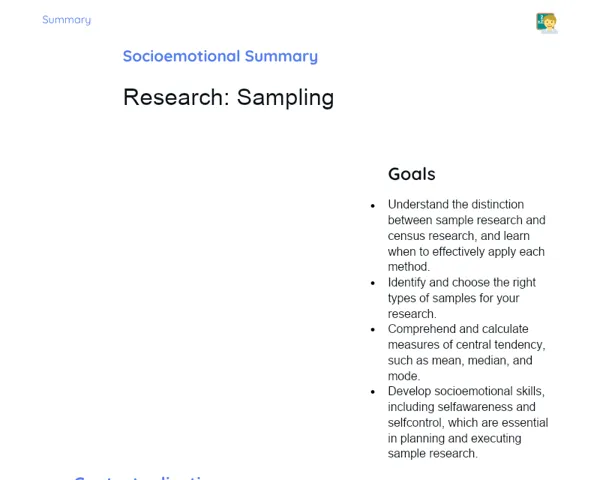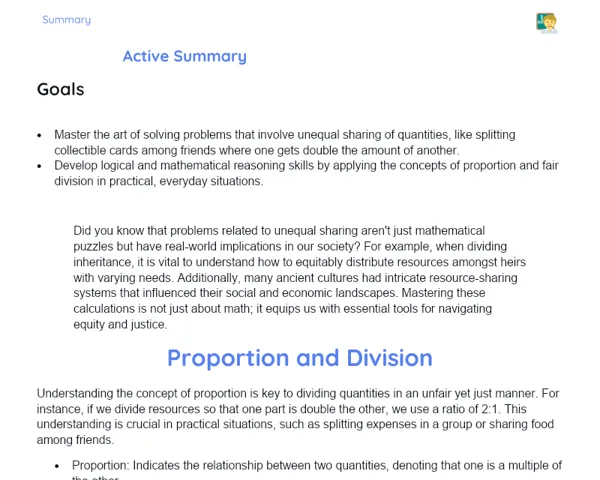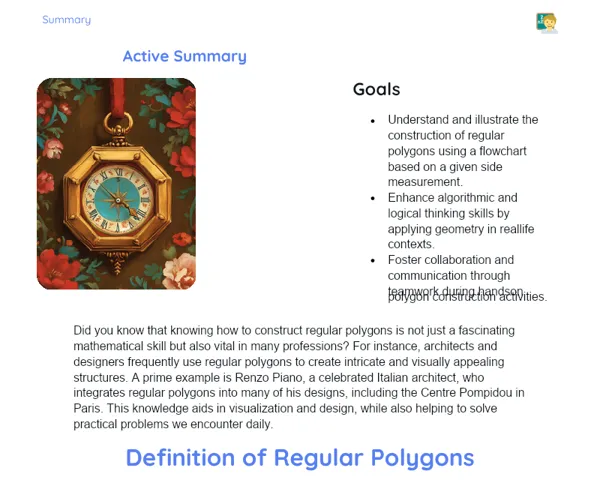Socioemotional Summary Conclusion
Goals
1. Analyze data presented in pie charts to identify patterns and trends 🧐📊
2. Understand when it's beneficial to use a pie chart compared to other types of charts 👀📉
3. Extract accurate information from pie charts, such as the percentages of specific responses 🎯🔢
Contextualization
Have you ever wondered why most opinion polls, election results, or even dividing that delicious pizza are shown as pie charts? 📈🍕 This is because pie charts effectively illustrate how different parts contribute to the whole, making complex information visually accessible and easy to grasp. In this lesson, we will explore how to interpret these wonderful charts and how they can assist us in making informed decisions in our everyday lives! 🌟🧠
Exercising Your Knowledge
Definition of Pie Chart
Pie charts, commonly referred to as pie graphs, are visual tools that divide a circle into 'slices' to depict proportions. Each slice represents a category, and its size is proportional to the quantity or percentage of that category concerning the whole. This visualization is particularly beneficial for demonstrating how various parts contribute to the whole, making information clearer and easier to understand.
-
Proportion Visualization: Pie charts enable a quick visual understanding of how each part contributes to the entire pie.
-
Categorical Representation: Each slice signifies a specific category, making comparisons more straightforward.
-
Ease of Interpretation: Thanks to their intuitive nature, pie charts can be understood without needing exact numerical data.
Components of a Pie Chart
A pie chart consists of several elements that aid in interpreting the information it conveys. These components include the title, the sectors or slices, the legend, and percentages, each serving a specific role in providing a clear and comprehensive visualization of the data.
-
Title: Gives insight into the subject or category represented by the chart, providing immediate context to the viewer.
-
Sectors/Slices: Each sector symbolizes a part of the whole, sized in relation to the value or percentage it indicates for quick visual comprehension.
-
Legend: Clarifies what each sector represents, usually employing different colors or patterns for easy differentiation between categories.
-
Percentages: Often displayed within the slices, showing the exact proportion of each part for a more precise understanding of the data.
When to Use Pie Charts
Pie charts are best for illustrating the composition of a category in relation to the whole, especially when it's necessary to understand and visually compare proportions. However, knowing when this type of chart is more suitable than other data visualization formats is crucial.
-
Proportion Comparison: Ideal for showcasing how different parts relate to the whole, such as in an election vote distribution.
-
Categorical Data: Best utilized with categorical data, where each slice represents a distinct category for easier understanding and comparison.
-
Category Limitation: Most effective when dealing with a limited number of categories; charts with too many categories can become confusing and hard to interpret.
Key Terms
-
Pie Chart: A chart that divides a circle into slices to represent proportions.
-
Percentage: A representation of a part concerning the whole, expressed as a percentage.
-
Legend: An element of the chart that explains what each slice represents.
-
Sector/Slice: Each component of the pie chart, symbolizing a specific category.
For Reflection
-
How can understanding pie charts assist you in making more informed choices in daily life? 💡🤔
-
What challenges do you encounter while working in groups, and how can you address them to interpret and present pie charts effectively? 👫💬
-
In what ways can analyzing pie charts enhance social awareness and empathy towards the diverse perspectives and needs within a community? 🌍❤️
Important Conclusions
-
Our exploration of pie charts enabled us to identify and analyze patterns and trends 📊🧐.
-
We learned when it's particularly useful to use pie charts as opposed to other chart types 📉👀.
-
We successfully extracted precise information from these charts, such as percentages and specific distributions 🎯🔢.
Impacts on Society
Pie charts significantly influence how we interpret and process information in our daily lives. For instance, they are frequently utilized in opinion polls to visualize how various groups perceive certain issues. This holds great importance in marketing strategies, public policy development, and even when making personal decisions 🤝📈.
On an emotional note, grasping the concept of pie charts can enhance our decision-making abilities and promote empathy. By recognizing the different proportions and needs of each group, we can become more attuned to the diverse viewpoints that shape our society. This understanding fosters a more inclusive and collaborative approach to tackling community challenges 🌍❤️.
Dealing with Emotions
To manage your emotions while studying pie charts, consider applying the RULER method. First, Recognize how you feel when encountering a new chart, whether it's anxiety or excitement. Understand the source of those emotions: is it the complexity of the data or the pressure to interpret it accurately? Label those emotions appropriately; perhaps you feel curious or even overwhelmed. Express those emotions constructively, such as through discussions with peers or taking detailed notes. Finally, Regulate your feelings; use strategies like deep breathing or regular breaks to maintain focus and reduce stress while studying 🧠🌟.
Study Tips
-
Create your own pie chart using data from something that interests you, like the allocation of time in your daily routines. This will enhance the learning experience and make it enjoyable! 📅🥧
-
Utilize different colors for each sector while jotting down notes on pie charts. This approach will aid in better visualization and retention of the information 🖍️🎨.
-
Study collaboratively and discuss various pie charts sourced from online or printed materials. Sharing insights can enrich your comprehension and make the study sessions more engaging! 👥💬



